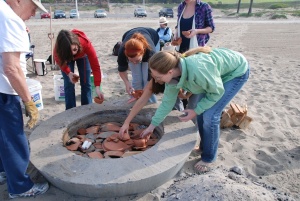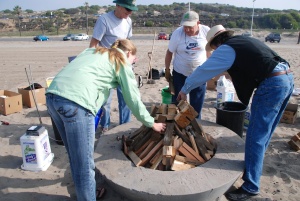The work described in this poster was conducted as part of a Master’s thesis project for the UCLA/Getty Conservation Program and presented at the Annual Conference of the Association of North American Graduate Programs in Conservation (ANAGPIC), Buffalo State College, April 24-25, 2009.
The Fowler Museum at UCLA houses a collection of Japanese polychrome wooden masks. A pair of these masks, identified as “honomen” (gift or dedication mask), was attributed to the same maker based on their stylistic similarities. The museum records stated that the masks were dated to the 18-19th century and made in the style found in the Kyūshū region of Japan. However, neither the pairing nor provenance of the masks was supported by any textual or technical evidence.
The poster presented here summarizes the preliminary results from a comparative technical investigation on the Fowler masks, as a part of the research to answer the questions regarding the masks’ provenance and their paired attribution. Analytical techniques such as wood characterization, polarized light microscopy (PLM), x-ray fluorescence spectroscopy (XRF), x ray diffraction (XRD), gas chromatography-mass spectrometry (GC-MS), pyrolysis-gas chromatography-mass spectrometry (Py-GC-MS) and micro-chemical analysis using environmental scanning electron microscopy (ESEM-EDX) were used to determine the masks’ material composition and methods of manufacture. The analytical results, combined with studies on the masks’ context of use and iconographic origins, provided material evidence that the masks were manufactured in close association with one another, although there was no firm evidence to establish that they were indeed manufactured by the same hand. Furthermore, identifying vitreous pigments on one of the masks pushed the mask’s estimated date of manufacture to 19th-20th century. This finding also added knowledge to a class of pigment not widely used in the Japanese palette until modern times.
Built upon the analytical understanding of the Fowler masks’ material composition and present condition, the research project concluded with a conservation treatment to improve the long-term stability of the polychrome. The most urgent treatment priorities were stabilizing the fragile matte paint surface and locally reinforcing the structural defects on the masks. Due to time constraints, consolidation of the paint was performed only on the red mask. Major structural defects on both masks were reinforced by filling the cavities in the wood with a light-weight and mechanically-reversible fill made of rolled-up Japanese paper, capped with a light-weight putty made from Acryloid B-72 bulked with glass microballoons for a better seal. The fill was then inpainted with Liquitex acrylic emulsion paint to reduce the color contrast between the fill and the wood.








